#Hagia Sophia Museum
Explore tagged Tumblr posts
Text
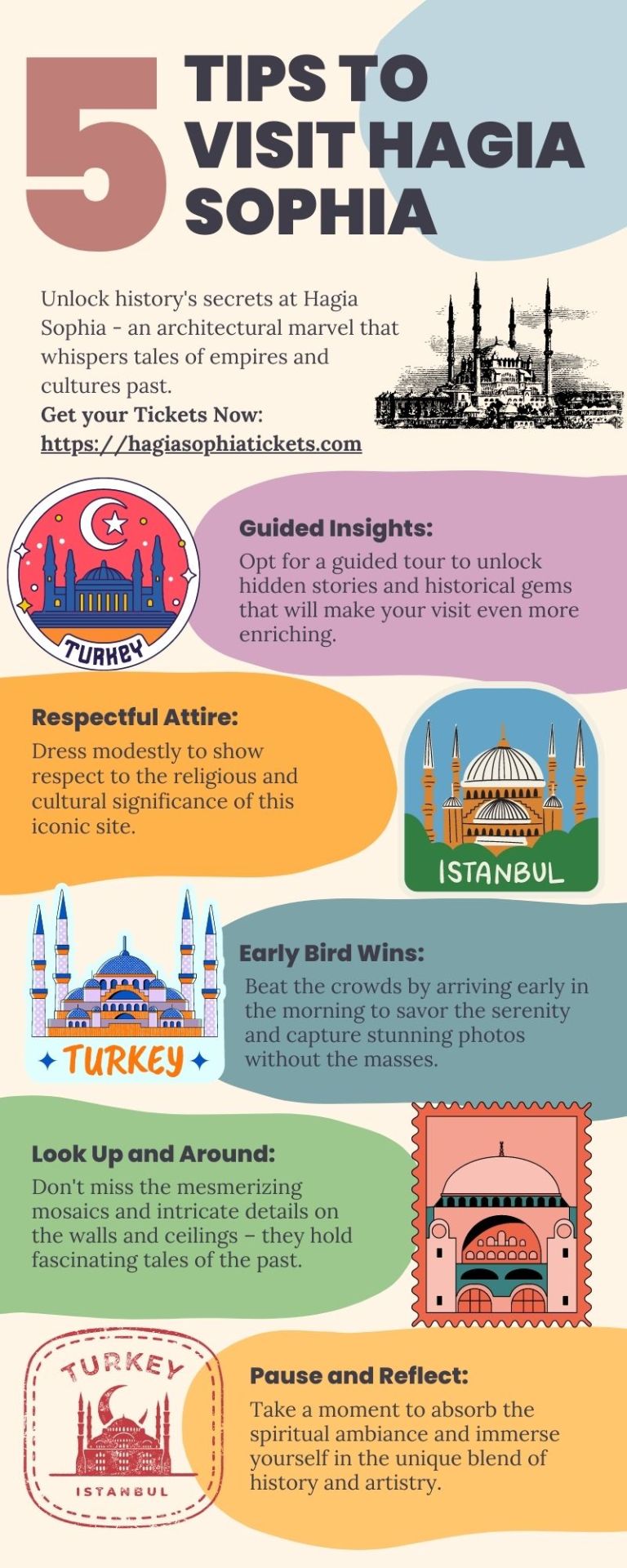
When visiting Hagia Sophia, consider these helpful tips to make the most of your experience. Firstly, plan your visit for weekdays, preferably Tuesdays to Thursdays, to avoid the weekend crowds. Arriving early in the morning shortly after the opening time allows for a more peaceful and immersive exploration of the monument. If possible, visit during the shoulder seasons of spring (April to May) or autumn (September to October) to avoid peak tourist numbers. Be mindful of local events and holidays to plan your trip around potential busy periods. Lastly, respect the cultural significance of Hagia Sophia, and dress modestly out of respect for its religious history and current status. Love Hagia Sophia! Learn about some amazing facts about Hagia Sophia here: 8 Amazing Historical Facts About Hagia Sophia
#travel#travel Istanbul#Hagia Sophia#Turkey#Hagia Sophia Mosque#Hagia Sophia Museum#Hagia Sophia Dome#Tips to visit Hagia Sophia#Explore Hagia Sophia#HagiaSophia#Hagia Sophia Church#Byzantine Art#Islamic Elements#Minarets#Hagia Sophia Mosaics#Istabul
2 notes
·
View notes
Text
Exploring Hagia Sophia: A Journey Through History And Beauty
Hagia Sophia, one of the most iconic landmarks in Istanbul, stands as a magnificent testament to the city’s rich and diverse history. Known as Ayasofya in Turkish, this architectural wonder has been a church, a mosque, and a museum, and today it serves as an active mosque. Its story is as fascinating as its breathtaking design, making it a must-visit destination for travelers worldwide. A Brief…

View On WordPress
#ancient architecture#architectural wonders#beautiful Istanbul#Byzantine architecture#cultural Istanbul#Hagia Sophia#Hagia Sophia architecture#Hagia Sophia church#Hagia Sophia details#Hagia Sophia dome#Hagia Sophia guide#Hagia Sophia history#Hagia Sophia interior#Hagia Sophia Istanbul#Hagia Sophia mosque#Hagia Sophia museum#Hagia Sophia secrets#Hagia Sophia tour#Hagia Sophia travel guide#historical landmarks#historical sites Istanbul#history of Hagia Sophia#iconic buildings Istanbul#Istanbul#Istanbul attractions#Istanbul landmarks#Istanbul tourism#Istanbul travel tips#Istanbul travel vlog#Istanbul UNESCO
0 notes
Text
Discovering the Enchanting Hagia Sophia Dome: A Timeless Wonder
Hagia Sophia, meaning "Holy Wisdom" in Greek, was originally built as a Christian cathedral during the reign of Emperor Justinian I in the 6th century. The construction of the Hagia Sophia Dome began in 532 CE and was a feat of engineering brilliance. It took only five years to complete, a remarkable achievement considering its complexity.
The Marvelous Dome Architecture The Hagia Sophia Dome is a true marvel of architectural innovation. Designed by gifted architects Anthemius of Tralles and Isidore of Miletus, the dome's construction was groundbreaking. It features an ingenious pendentive construction—a triangular, curved segment that supports the dome's transition from its circular base to the square walls below.
The architects used a combination of bricks and lightweight mortar to reduce the overall weight on the pendentives, allowing the dome to soar to a height of approximately 55.6 meters (182 feet). The result is a breathtakingly beautiful and structurally sound dome that continues to inspire architects and engineers to this day.
A Tale of Symbolism and Transitions Over the centuries, the Hagia Sophia Dome has witnessed significant transitions and transformations. Originally a Christian cathedral, it hosted numerous religious ceremonies and imperial events. With the conquest of Constantinople by the Ottoman Empire in 1453, it was converted into a mosque, adorned with Islamic elements such as minarets, mihrabs, and calligraphy.
In 1935, under the administration of Mustafa Kemal Atatürk, Hagia Sophia was transformed into a museum, becoming a symbol of secularism and celebrating Turkey's diverse history and cultural heritage. This cultural treasure has served as a bridge between different cultures and religions, representing unity and understanding.
The Controversy Despite its historical significance, the Hagia Sophia Dome has been a subject of controversy in modern times. The debates revolve around its status as a museum, mosque, or interfaith space. While its past transitions are a testament to its ability to adapt and embrace change, the question of its current purpose sparks passionate discussions among various stakeholders.
Preserving the Treasure Recognizing its value as a UNESCO World Heritage Site, the Turkish government, along with international organizations, has devoted considerable efforts to preserve and restore the Hagia Sophia Dome. The goal is to ensure that this extraordinary monument stands tall for generations to come, enchanting visitors from all corners of the world.
A Timeless Wonder The Hagia Sophia Dome remains a timeless wonder, weaving together the threads of history, art, and architecture. Its breathtaking design and rich history offer a glimpse into the human spirit's creativity and perseverance. As you stand beneath its awe-inspiring dome, you can't help but be transported back in time, feeling the echoes of the past and the weight of history.
Visiting the Hagia Sophia Dome is an unforgettable experience, where you can immerse yourself in the cultural tapestry of Turkey and marvel at the brilliance of ancient architecture. Each intricate detail of the dome tells a story, and every corner holds secrets waiting to be discovered.
Whether you are an architecture enthusiast, a history buff, or simply a curious traveler, the Hagia Sophia Dome will leave an indelible mark on your soul. Its allure, beauty, and significance will continue to inspire generations, reminding us of the remarkable achievements of humanity and the importance of preserving our cultural heritage.
So, the next time you find yourself in Istanbul, don't miss the opportunity to experience the enchantment of the Hagia Sophia Dome—a timeless wonder that stands as a testament to the ingenuity and creativity of human civilization.
#Hagia Sophia#Hagia Sophia Dome#Hagia Sophia Inetriors#Hagia Sophia Architecture#Istanbul#Explore Hagia Sophia#Hagia Sophia Interiors#Hagia Sophia Mosque#Hagia Sophia Museum#Hagia Sophia Church#Turkey#Visit Hagia Sophia#Mosque
1 note
·
View note
Text
Emperor Door ∼ Hagia Sophia

#Hagia Sophia#Emperor Door#Religious Art#Deesis#Mosaic#Art#Bronze#Oak#Door#Ottoman#Mosque#Byzantium#Church#Justinian#Architecture#Constantinople#Ayasofya#Museum#Istanbul#Turkey
105 notes
·
View notes
Text






Hagia Sophia, Estambul
83 notes
·
View notes
Text

📍Hagia Sophia of Trabzon
#trabzon#trabzon haber#karadeniz#black sea#trabzonspor#ayasofya#hagia sophia#museum#müze#gezi#geziyorum#gezilecekyerler#gezinti#gezi rehberi#seyyah#gezmek#günün fotoğrafı#gününkaresi#photooftheday#beautiful photos#photoblog#photography#fotoğraf#fotoğrafçılık#blogger#lifestyle blog#new blog post#blog post#beauty blog#new blog
42 notes
·
View notes
Text
Istanbul: Where East Meets West in a Feast for the Senses
Dubai may have its Burj Khalifa, but Istanbul boasts a history stretching back millennia. This vibrant Turkish metropolis straddles the Bosphorus Strait, where Europe and Asia converge, offering a unique blend of cultures evident in its mosques, palaces, and bustling bazaars. Immerse Yourself in History Hagia Sophia: Once a church, then a mosque, and now a museum, Hagia Sophia is a architectural…
1 note
·
View note
Text
Istanbul: Rich History, Vibrant Culture | Ultimate Travel Guide 2023

View On WordPress
#2023#budget trip#christian#culture#election#erdogan#featured#film#Hagia sophia#history#islam#istanbul#museum#ottoman#religion#safety in istanbul#Türkiye#travel#turkey#turkish
1 note
·
View note
Text

One of two huge marble lustration (ritual purification) urns that were brought to the Hagia Sophia from Pergamon during the reign of the Ottoman Sultan Murad III. They are from the Hellenistic period and were carved from single blocks of marble in the 2nd century BCE. Istanbul, Turkey
More: https://thetravelbible.com/museum-of-artifacts/
908 notes
·
View notes
Text

what was their fucking problem
researching with adhd is dangerous stuff. i tried to look up stuff about angels in islam and thirty minutes later here i am enthralled doing a deep dive on the wikipedia entry for the hagia sophia mosque
#tldr; the hagia sophia is a mosque (islamic place of worship) that got converted into a museum during ww2#and stayed like that until fairly recently in 2020 when they unmuseumed it. now it's a mosque again#and quite a few people were very much not happy it was no longer a tourist attraction#mind you im getting this information secondhand from the internet and im dramatically not islamic#idk. if they wanna use a mosque like a mosque good for them. it's interesting to read about at least
14 notes
·
View notes
Text
first full day updates and things that I loved,
Seeing the Blue Mosque in the morning, the Basilica Cistern, the Hagia Sophia and its museum to learn its history over the centuries, and the grandeur of the harems at the Topkapi Palace :)) as someone who loves Islamic art and architecture, I was in paradise. Walking through Topkapi Palace, I daydreamed about having that giant, beautiful space to live and hang out with David and Westin and my friends ❤️
Eating street food (grilled corn!! hot roasted chestnuts!!)
Cats continue to be EVERYWHERE
Food!! Lamb kebab platter today was 🔥
I've seen very little of the city, but so far, I think I'm falling in love with it like I did with Kyoto and Taipei. It's so ancient, and I love how old it is, and how much history it carries. The ancient spaces I saw were so beautifully preserved for visitors across the centuries to enjoy, and it really captured my imagination.
other things,
I wish it was warmer - it was about 36 F / 2 C today and wet, and that got to me after all day walking outside! It should warm up every day that I'm here though :)
11 notes
·
View notes
Note
WAIT WHAT she actually animates beyond the door even tho we can’t see her after we talk to her? I wonder if the devs had originally had her accessible for a time
SHE DOES! it's just a few seconds looking at each paintings, and you can see her through the focus if you stand close to the vault door, so she's very much there, and she's very much walking around.
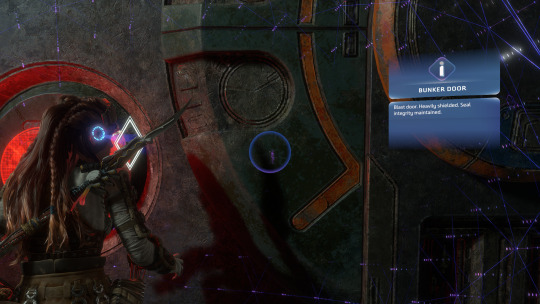

now since she doesn't have anywhere else to go (that we know of) I'm assuming she stays in the vault until Aloy brings Sylens "to heel" as she says. Thing is, you're not supposed to stay in an art vault for very long periods of time, because the air quality and humidity needs to be very exact for art to be preserved, the gasses in the air are not ideal for human lungs. When i visited a museum with my university, we were allowed entry to one of the storage vaults, to see how conservation works, and how art pieces are stored when not on display, and IIRC you're not supposed to stay there for more than... an hour, maybe 2 at a time? so that makes me curious as to how much of Tilda's body has been altered with the nano-tech the Zeniths have. (I haven't played burning shores yet, so i have no idea if more lore is revealed there, but my guess is that we learn a bit more about them)
Like the paintings were already really old when Tilda got her hands on them, the oldest piece being Lidded ewer, by Adam van Vianen, 1614, and the Aloy being born in 3021, that makes the piece at least 1427 years old by the time Aloy sees it, compared to it's 410 years today in our timeline. that is impressive conservation considering no-one was there to monitor the vault and it's content at all. like in comparison, art that is 1427 years old to us, is from 597 ad, that's when England adopted the Julian calendar, so wer're talking Byzantine art period, like the Hagia Sophia was built between 532-37 AD. and as a visual reference to what a lot of western art looked like around that time, here is a mosaic panel of Empress Theodora, from around the 540s, in the church of San Vitale in Ravenna.
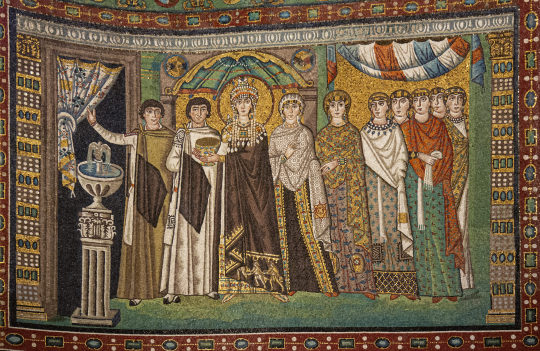
like this is the span of time we're talking about, this is so fucking old, and i just fhjdshafjkds have a lot of thoughts around that.
ofc we can assume that conservation tech was pretty evolved from what it is today, but i still believe human hands would have a large part in conservation... as an art-history student, i just have a lot of thoughts around Tilda and her vault FJKDSJLKF
#anon ask#tilda van der meer#babbling#Bram rambles about art history#horizon forbidden west#dont qoute me on the exact years i was in a hurry to reply to this cuz im getting ready for work
31 notes
·
View notes
Text



The famous Turkish mosque, Hagia Sophia, and the surrounding square, filled with pedestrians and horse-drawn vehicles. 1858-99
Albumen silver print by Abdullah Frères (Armenian, active 1860s - 1890s), photographer
J Paul Getty Museum, 2, 3
13 notes
·
View notes
Text


Built in 537 AD, the Hagia Sophia was the world's largest church for a thousand years... When the Roman Empire shifted its capital from Rome to Constantinople, it needed a monumental centerpiece.
"O Solomon, I have surpassed thee!", cried Emperor Justinian upon completion.

But it hadn’t been a church for centuries. After the Ottomans took Constantinople in 1453, it spent 5 centuries as a mosque before becoming a museum.
Eastern Christianity's ancient wonder, was more recently converted to a mosque in July 2020. A few months later, its symbolic replacement was completed in Serbia, modeled on the majestic dome of the original.

Now, it has been revived in Serbia. But why Serbia?
Like the Hagia Sophia, Serbia too fell under Ottoman occupation in the 1400s. It was the start of several punishing centuries for Serbian Christians, during which the Ottomans cruelly burned the body of Saint Sava, the father of Serbian Orthodoxy.


Once free of Ottoman rule in 1878, plans hatched to rekindle Serbian national identity with a new church in Sava's name. Similar projects were happening across the newly-independent Balkan states, like Bulgaria's Alexander Nevsky Cathedral:

the interior mosaics are the real wonder. They took years longer to finish and cost as much as the structure itself did to build. It's the world's largest mosaic composition, with over 50 million pieces.

The ensemble had to wrap Serbian saints in with the universal Christian story, across 161,000 square feet of curved surface — without being distorted when viewed from the ground.
Culminating in the central dome's icon of Christ's Ascension — this mosaic alone weighs 11 tons.
"Weaving in millions of glittering pieces into one single message of brotherhood and solidarity".

9 notes
·
View notes
Text
Day 19 - 24 September - Thessaloniki
Woke up quite early due to the fact that we are now an hour earlier that we were before. I nipped out and got some coffee from a shop and wrote my diary from the day before. I then went out and looked at 5 of the 15 or so churches in the city that are Unesco world heritage sights. They are all Byzantine churches that had been turned into mosques by the Ottomans when they took over Selonica as it was called in the 15th century. They were subsequently turned back into churches when the city became part of Greece in 1912, which seems fair enough. I did see an old Ottoman bath house that looks pretty dilapidated and the google reviews all spoke about how much of a shame it is that the ottoman history is not being looked after by the government.


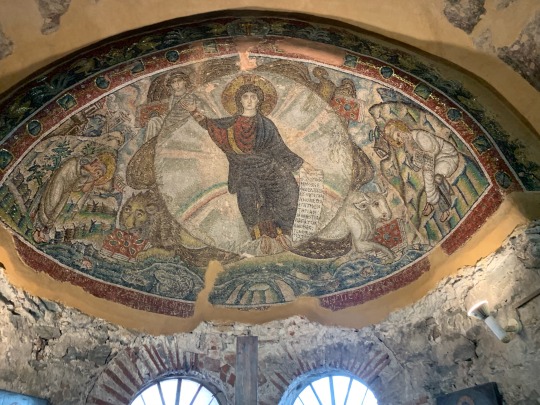
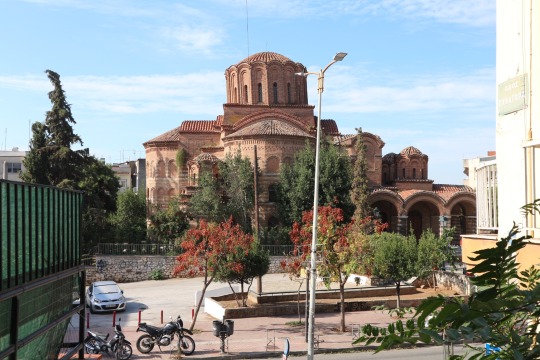

I then met Nin and we had an espresso fredo (Briki on Exmouth Market do these and I highly recommend them!) in this nice cafe and then went to the Jewish museum.
Selonica had at one point, the largest Jewish population in Europe, many of whom ere Sephardic Jews who had settled and thrived in the city under the Ottomans after their expulsion from Spain. Almost the whole population was killed when the occupying German forces transported them to the extermination camps in Poland. They had a room which had the names of the people confirmed killed which was incredibly stark. The gallery of Srebrenica had something similar with photos of the confirmed dead (a much smaller number compared with here) each of those people was a person with a life, a family, friends, interests, and when you hear deaths in numbers that is often lost. I think we as a society have a problem being able to communicate and conceptualise the scale of the violence that has happened in the last hundred and twenty years, and that the impact of it remains to this day in our politics and in our society.
The city, despite being in the Ottoman Empire for so long has almost no Muslim population after the forced population swaps in the early 1920s. Lots of the 1m Greek who moved from Anatolia and Thrace we settled here as well as in Attica. At the time of the Armenian Genocide that took place at then end of WW1 there were large numbers of killings of Christian Greeks and Assyrians which continued following the Greco/Turkish war in 1919-22. Which considering the multiculturalism of the Ottoman Empire, the fact that people who would have lived in an area for hundreds maybe even thousands of years then have to move to another country just because of their religion or language, is one of the great tragedies of the nationalism of the early 20th Century (and beyond).
After the museum, we went to the seafront and walked along it. We were originally going to go to this Feta bar we had read about but in the end we went for a giros which was absolutely delish (as I write this I have only had food in a wrap in this city. We then walked to the Hagia Sophia (church no.6) and looked around. We were going to go to the Rotunda church but that was closed on Tuesdays (as are lots of things it seems).
We then walked back to our flat and chilled out for a bit and then went to the bar on our corner for a drink. We had a strange situation where the dogs of a guy sat beside us bit the owner of a shop next door and no one really seemed to bat an eyelid.
The weather is really nice, not too hot but still quite sunny. We then went to a shop and bought food for dinner. After that I read till I went to bed.
Where we ate - Derlicatesen all Souvlaki, at home
What we liked - Both were very good loved the souvlaki
Day 19 - 24 September - Thessaloniki
Woke up and went on a run to the bus station in order to buy our ticket to Alexandropoli tomorrow. We then took a bus back into the town and had our first fredo coffee of the day (fredo-cappucino), we then went to apartment and got ready for the day. We went to the do a quick-fire blitz of churches before lunch. They really were stunning, with fragments of frescos and mosaics. One of the places we went to was the rotunda which was pretty amazing.
We then went to a place that had been recommended in an article which we weren’t enamoured by and the food was a bit cold. After that walked along the water and moved toward the Byzantine museum, it was very hot so we tried to stay in the shade and were very happy when we went into the building and it was very cool. The museum was very interesting and informative, it had lots of mosaics and frescos as well as lots of stone headstones and pillars etc.
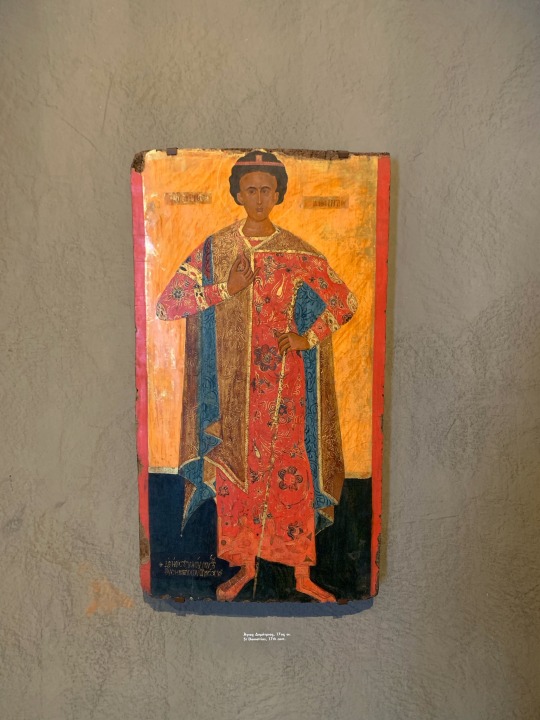

After that we had a very nice coke and water in a cafe outside another museum which was needed as we were thirsty and it was very refreshing (as it was still pretty hot). We then walked up towards the flat. On the way I bought a hat, which was good because I had been looking to buy a hat for a while because the one I have is not very nice (although it is very useful and washable). We had another coffee and went back to the flat and chilled out for a bit.


We then got up again and went up to the top of the hill behind us where some of the old walls are. There was a lovely view over the whole town which was great. After that we went to a tavern called Iggis which we had heard from the same article, which was actually delish, it was in a nice setting and we had some great food and some lovely wine. After that we walked back to the flat and chilled out.
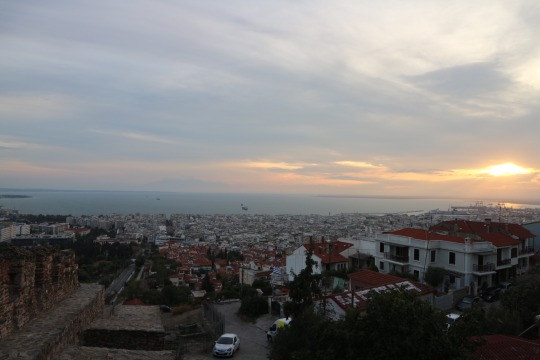
Where we ate - Local, Iggis
What we liked - Local - not very good, quite expensive an disappointing, Iggis - really nice, we had a some white tarama, and fava beans, as well as a salad of wilted spinach leaves with mint and lemon which was lovely. I then had a beef and smokey aubergine dish and Nin had a great pork neck grilled, there were great chips too!
2 notes
·
View notes
Photo





Greek God Pan Statue Unearthed in Istanbul
A Pan statue thought to belong to the Roman period was recovered during excavation works carried out by Istanbul Metropolitan Municipality (IBB) teams at Saraçhane Archaeology Park, where the Church of St. Polyeuctus is located.
There are modest ruins of a structure that was once the largest church in Constantinople and was constructed to resemble the Solomon Temple in Jerusalem in a small park right in the middle of Istanbul’s Fatih neighborhood, close to the location of the Istanbul Metropolitan Municipality.
Before the erection of the new Hagia Sophia by Emperor Justinian in 537, the Church of Saint Polyeuctus was the largest temple in Constantinople.
The church in the Saraçhane district of Istanbul was destroyed after being used for various purposes. However, after some historical artifacts belonging to the church were discovered during the construction of an underpass in the 1960s, excavation works were carried out in the church. After six years of hiatus, the excavation work was paced by the IBB Heritage teams affiliated with the Cultural Affairs Directorate.
During the excavations carried out by archaeologists, the Statue of Pan, which is considered to be 1700 years old, was found 2 meters 60 centimeters below the ground. The left arm and underbody parts of the 20-centimeter-high, 18-cm-wide statue were found to be broken.
While the statue is estimated to belong to the Roman period, the exact period to which it belongs will be determined after the examinations. The found part of the Pan statue was taken to the warehouse of the Archeology Museums Directorate.
Although it is said that there are many palaces and structures belonging to the Theodosius family in the Saraçhane or Constantinianae region, a palace structure whose location has been determined has not been found until today, except for the Church of St Polyeuctus.
In a statement made by İBB Deputy Secretary General Mahir Polat on his social media account, he said that they had reached the lost Roman Palace section of Istanbul together with another Roman statue that was unearthed recently.
Pan is considered to be one of the oldest of Greek Gods. He is associated with nature, wooded areas, and pasturelands, which is where his name comes from. Pan worship began in rural areas far from populated city centers. As a result, he did not construct large temples to worship him. Pan worship was instead centered in nature, often in caves or grottos. He ruled over shepherds, hunters, and rustic music.
By Leman Altuntaş.
#Greek God Pan Statue Unearthed in Istanbul#Church of St. Polyeuctus#ststue#ancient artifacts#archeology#archeolgst#history#history news#ancient history#ancient culture#ancient civilizations#roman history#roman empire#roman art
30 notes
·
View notes